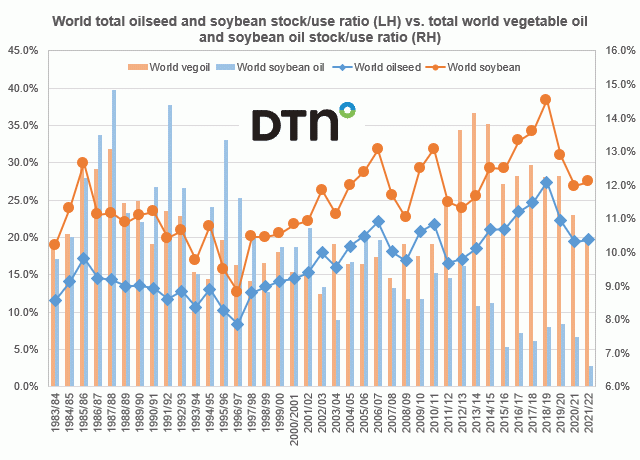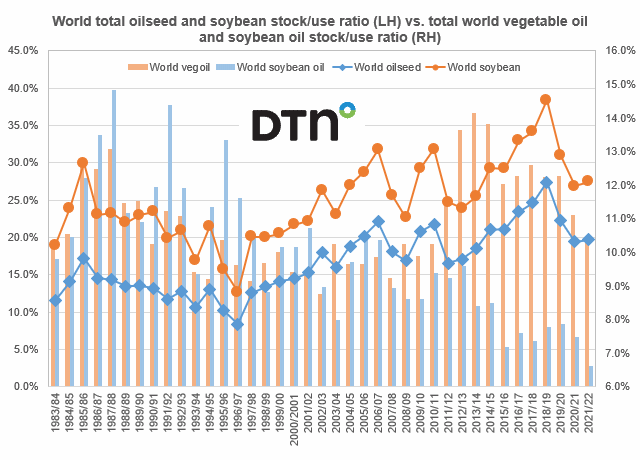Fundamentally Speaking
USDA Forecasts for Corn Feed Use, Total Meat and Poultry Output
In its last WASDE report, USDA in its initial estimates for the 2020/21 marketing year, projected corn use for feed/residual consumption at 6.050 billion bushels (bb), 350 million bushels (mb) greater than 2019/20 on increased grain consuming animal units (GCAU), a larger crop, and lower expected prices.
Certainly, given the woeful demand scenario and a forecasted record crop stocks will be huge and prices depressed.
As for the increase in grain consuming animal units, USDA is looking for a 1.4% increase though meat production and demand is still an open question and perhaps USDA is being too optimistic.
Set aside the problems with falling production at the nation's slaughterhouses and packing plants due to workers and USDA inspectors falling sick to the coronavirus, the attached graphic suggests there is some loose relation between the annual percent change in the U.S. gross domestic product (GDP) which is the output of all goods and services and the annual percent change in both total U.S. red meat and poultry production and demand especially in recessionary conditions when GDP is actually contracting as it is now.
The Commerce Department reported that GDP fell at an annual rate of 5% in the first quarter, a bigger decline than the 4.8% drop first estimated a month ago.
P[L1] D[0x0] M[300x250] OOP[F] ADUNIT[] T[]
It was the biggest quarterly decline in more than a decade, since an 8.4% fall in the fourth quarter of 2008 during the depths of the financial crisis.
Economists feel the mandated lockdowns that virtually shut the economy and triggered layoffs of millions of workers will send the GDP sinking at an annual rate of 40% in the current quarter.
That would be the biggest quarterly decline on records that go back to 1947 and for the year even with a second half recovery it will end the year down by 5%.
As for 2021, economists say that the economy will likely not achieve sustained GDP gains until a vaccine has been found and it is widely available, something that could still be a year or more away.
This chart shows the annual percent change in both total U.S. red meat and poultry production and consumer demand as defined by per capita disappearance on a retail weight basis on the left hand axis while on the right hand axis is the year to year percent change in U.S. GDP.
For perspective, a number of analysts have looked to the 2008-09 period of the financial crisis with GDP down 0.1% in 2008 before the economic contraction worsened the following year with GDP off 2.5%.
Up until now, this was the worst downturn since the Great Depression with capita disappearance on a retail weight down 2.5% each year though output was up 2.9% in 2008 before the full impact of the crisis took root for in 2009 total U.S. red meat and poultry production fell by 3.2%.
This year production is forecast to fall just 1.6% which may be low if rates of slaughter do not recover and demand stays tepid, though a robust rebound is forecast for next year at up 3.7%, the highest rate since 1999.
For this year, per capita disappearance on a retail weight basis is forecast down 3.2%, the largest annual percent decline since 1975.
It was also a recession year, though inflation was also raging at the time, while for 2021 it is projected to increase by 2.9% which would be the third largest annual increase in 50 years.
Clearly, what GDP will do the second half of this year and all of next year is an open question but with regard to U.S. total red meat and poultry production and demand, it appears that these projections are based on a robust recovery from the ongoing pandemic which hopefully happens. Note that the White House has decided not to release an updated economic forecast.
© (c) Copyright 2020 DTN, LLC. All rights reserved.






Comments
To comment, please Log In or Join our Community .